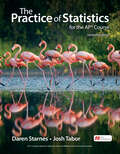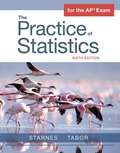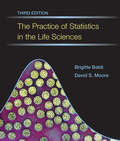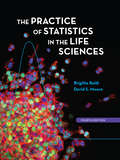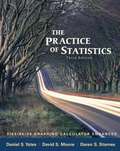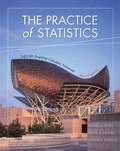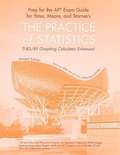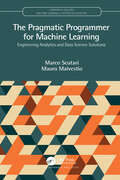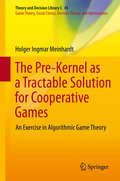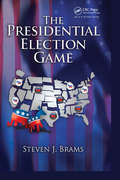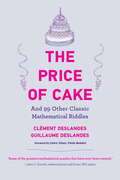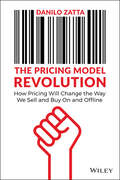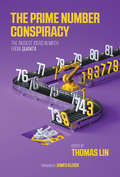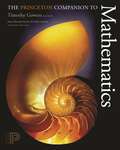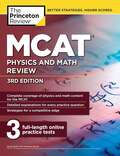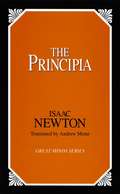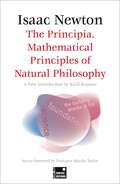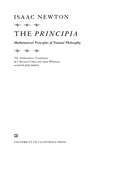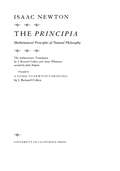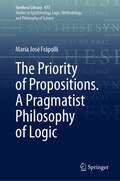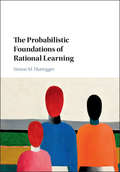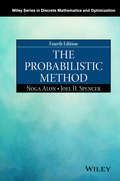- Table View
- List View
The Practice of Statistics for the AP® Course
by Josh Tabor Daren StarnesExperience the best: The Practice of Statistics is the ultimate choice for AP® Statistics.Authored by seasoned high school AP® Statistics educators, Daren Starnes and Josh Tabor, along with a team of experienced AP® teacher/leaders, the Seventh Edition of The Practice of Statistics brings a fresh perspective through 9 Units that align perfectly with the CED.Created to instill a deep understanding of the core principles of statistics and the problem-solving methods involved, TPS7 equips students with the essential statistical thinking skills necessary for future endeavors, careers, and everyday decision-making, while also ensuring success on the AP® Statistics Exam. With a multitude of worked examples and practice exercises strategically placed throughout, students have plenty of opportunities to strengthen their skills on a daily basis and prepare for the exam format.And thats not all - the renowned resource program now offers even greater support with the introduction of the new Achieve digital platform. The online homework program has been revamped to provide an extensive homework and assessment system, offering comprehensive support for daily assignments, quizzes, and tests. For students who may be struggling or seeking an extra challenge, the extensive video program is there to offer guidance. Meanwhile, teachers are backed by the most comprehensive Teachers Edition and resource program available. No matter if youre a first-time or experienced AP® Statistics teacher, this program is perfect for you.Better than ever: The Practice of Statistics is the most trusted program for AP® Statistics.
The Practice of Statistics for the AP® Exam
by Josh Tabor Daren Starnes Ann Heath Donald Gecewicz Lumina DatamaticsNIMAC-sourced textbook
The Practice of Statistics for the AP® Exam
by Daren S. Starnes Josh TaborAlong came Dan Yates. His vision for such a text became reality with the publication of The Practice of Statistics (TPS) in 1998. Over a million students have used one of the first five editions of TPS for AP® Statistics! Dan also championed the importance of developing high-quality resources for AP® Statistics teachers, which were originally provided in a Teachers' Resource Binder. We stand on the shoulders of two giants in statistics education as we carry forward their visions in this and future editions. The Practice of Statistics has continued to evolve, thanks largely to the support of our longtime editor and team captain, Ann Heath. Her keen eye for design is evident throughout the pages of the student and teacher's editions. More importantly, Ann's ability to oversee all of the complex pieces of this project while maintaining a good sense of humor is legendary. Ann has continually challenged everyone involved with TPS to innovate in ways that benefit AP® Statistics students and teachers. She is a good friend and an inspirational leader.
The Practice of Statistics in the Life Sciences
by David S. Moore Brigitte BaldiThis remarkably engaging textbook gives biology students an introduction to statistical practice all their own. It covers essential statistical topics with examples and exercises drawn from across the life sciences, including the fields of nursing, public health, and allied health. Based on David Moore's The Basic Practice of Statistics, PSLS mirrors that #1 bestseller's signature emphasis on statistical thinking, real data, and what statisticians actually do. The new edition includes new and updated exercises, examples, and samples of real data, as well as an expanded range of media tools for students and instructors.
The Practice of Statistics in the Life Sciences (Fourth Edition)
by David S. Moore Brigitte BaldiThis remarkably engaging textbook gives biology students an introduction to statistical practice all their own. It covers essential statistical topics with examples and exercises drawn from across the life sciences, including the fields of nursing, public health, and allied health. Based on David Moore's The Basic Practice of Statistics, PSLS mirrors that #1 bestseller's signature emphasis on statistical thinking, real data, and what statisticians actually do. The new edition includes new and updated exercises, examples, and samples of real data, as well as an expanded range of media tools for students and instructors.
The Practice of Statistics: TI-83/84/89 Graphing Calculator Enhanced
by David S. Moore Daniel S. Yates Darren S. StarnesNIMAC-sourced textbook
The Practice of Statistics: TI-83/89 Graphing Calculator Enhanced (2nd Edition)
by David S. Moore Daniel S. Yates Daren S. StarnesTailored to mirror the AP Statistics course, The Practice of Statistics became a classroom favorite. This edition incorporates a number of first-time features to help students prepare for the AP exam, plus more simulations and statistical thinking help, and instructions for the TI-89 graphic calculator.
The Practice of Statistics: TI-83/89 Graphing Calculator Enhanced (Prep for the AP Exam Guide)
by Larry PetersonBuilding on the "Prep for the AP Exam" feature on the Web, this study guide contains four full-length sample exams to help student refresh their skills and prepare for the actual AP Exam.
The Pragmatic Programmer for Machine Learning: Engineering Analytics and Data Science Solutions (Chapman And Hall/crc Machine Learning And Pattern Recognition Ser.)
by Marco Scutari Mauro MalvestioMachine learning has redefined the way we work with data and is increasingly becoming an indispensable part of everyday life. The Pragmatic Programmer for Machine Learning: Engineering Analytics and Data Science Solutions discusses how modern software engineering practices are part of this revolution both conceptually and in practical applictions. Comprising a broad overview of how to design machine learning pipelines as well as the state-of-the-art tools we use to make them, this book provides a multi-disciplinary view of how traditional software engineering can be adapted to and integrated with the workflows of domain experts and probabilistic models. From choosing the right hardware to designing effective pipelines architectures and adopting software development best practices, this guide will appeal to machine learning and data science specialists, whilst also laying out key high-level principlesin a way that is approachable for students of computer science and aspiring programmers.
The Pre-Kernel as a Tractable Solution for Cooperative Games
by Holger Ingmar MeinhardtThis present book provides an alternative approach to study the pre-kernel solution of transferable utility games based on a generalized conjugation theory from convex analysis. Although the pre-kernel solution possesses an appealing axiomatic foundation that lets one consider this solution concept as a standard of fairness, the pre-kernel and its related solutions are regarded as obscure and too technically complex to be treated as a real alternative to the Shapley value. Comprehensible and efficient computability is widely regarded as a desirable feature to qualify a solution concept apart from its axiomatic foundation as a standard of fairness. We review and then improve an approach to compute the pre-kernel of a cooperative game by the indirect function. The indirect function is known as the Fenchel-Moreau conjugation of the characteristic function. Extending the approach with the indirect function, we are able to characterize the pre-kernel of the grand coalition simply by the solution sets of a family of quadratic objective functions.
The Presidential Election Game
by Steven J. BramsThe Presidential Election Game may change the way you think about presidential elections and, for that matter, American politics in general. It is not filled with statistics about the voting behavior of citizens, nor does it give detailed histories of past campaigns. Rather, it is an analytic treatment of strategy in the race for the presidency, fr
The Price of Cake: And 99 Other Classic Mathematical Riddles
by Clément Deslandes Guillaume DeslandesIngeniously designed mathematical riddles to delight armchair—and seasoned—mathematicians, in high school and beyond.In The Price of Cake, brothers Clément and Guillaume Deslandes have assembled a uniquely rich and accessible collection of mathematical riddles, organized by difficulty and accompanied by unique hand-drawn illustrations. The challenges are exceptional in both their range and their precision. There are no &“tricks&” here—just good math to test your skills. While any student will be thrilled to encounter fresh presentations of classic conundrums such as Simpson&’s paradox, Hilbert's infinite hotel, Monty Hall&’s paradox, and Seven Bridges of Königsberg, seasoned solvers will also appreciate challenging original puzzles using the Axiom of Choice and Conway&’s Soldiers problem. The Deslandes&’ lucid and elegant solutions offer new insights, as they seamlessly connect the skills applied in each problem to broader theoretical revelations. Moreover, as Fields Medalist Cédric Villani writes in his preface, these riddles are much more than just exercises. They capture &“a certain dose of decorum and mystery,&” and to decipher them will require both imagination and tenacity. To aid you on this journey, the authors provide hints to each puzzle, detailed proofs and solutions, and a series of Math Refreshers to revisit important concepts that are used to arrive at those answers. Entertaining and rigorous in equal measure, The Price of Cake is bound to captivate mathematics enthusiasts and students of all levels.
The Pricing Model Revolution: How Pricing Will Change the Way We Sell and Buy On and Offline
by Danilo ZattaAn incisive and accessible blueprint to pricing your company’s products and services In The Pricing Model Revolution: How Pricing Will Change the Way We Sell and Buy On and Offline, world renowned pricing expert Danilo Zatta delivers an essential and engaging blueprint to building an enduring competitive advantage with insightful pricing models. In the book, you’ll learn to identify the best monetization approaches for your products and how to execute the one that makes the most sense for your business. From freemium to subscription, pay-per-use, and even neuropricing, the author discusses every available option and shows you how to choose. Although it's rigorous and evidence backed, The Pricing Model Revolution avoids an overly academic perspective in favour of providing you with concrete, practical guidance you can apply immediately to start generating more revenue. You’ll learn things like: How to make smart and innovative pricing a core component of your next product offering How to distinguish between every new, future-oriented monetization approach Which factors to consider when you’re choosing on a new pricing model for your most popular products An essential read for C-level executives, managers, entrepreneurs, and sales team leaders, The Pricing Model Revolution belongs on the bookshelves of every business leader seeking to learn more about one of the foundational topics driving top-line revenue and bottom-line profitability today.
The Pricing of Progress: Economic Indicators and the Capitalization of American Life
by Eli CookHow did Americans come to quantify their society’s well-being in units of money? In our GDP-run world, prices are the measure of not only goods and commodities but our environment, communities, nation, even self-worth. Eli Cook shows how, and why, we moderns lost sight of earlier social and moral metrics that did not put a price on everyday life.
The Primacy of Doubt: From Quantum Physics to Climate Change, How the Science of Uncertainty Can Help Us Understand Our Chaotic World
by Tim Palmer&“Quite possibly the best popular science book I&’ve ever read&” (Popular Science) shows how the tools that enabled us to overcome the uncertainty of the weather will enable us to find new answers to modern science's most pressing questions Why does your weather app say &“There&’s a 10% chance of rain&” instead of &“It will be sunny tomorrow&”? In large part this is due to the insight of Tim Palmer, who made uncertainty essential to the study of weather and climate. Now he wants to apply it to how we study everything else. In The Primacy of Doubt, Palmer argues that embracing the mathematics of uncertainty is vital to understanding ourselves and the universe around us. Whether we want to predict climate change or market crashes, understand how the brain is able to outpace supercomputers, or find a theory that links quantum and cosmological physics, Palmer shows how his vision of mathematical uncertainty provides new insights into some of the deepest problems in science. The result is a revolution—one that shows that power begins by embracing what we don&’t know.
The Prime Number Conspiracy: The Biggest Ideas in Math from Quanta (The\mit Press Ser.)
by Thomas LinQuanta Magazine's stories of mathematical explorations show that “inspiration strikes willy-nilly,” revealing surprising solutions and exciting discoveries.If you're a science and data nerd like me, you may be interested in "Alice and Bob Meet the Wall of Fire" and "The Prime Number Conspiracy" from Quanta Magazine and Thomas Lin. - Bill GatesThese stories from Quanta Magazine map the routes of mathematical exploration, showing readers how cutting-edge research is done, while illuminating the productive tension between conjecture and proof, theory and intuition. The stories show that, as James Gleick puts it in the foreword, “inspiration strikes willy-nilly.” One researcher thinks of quantum chaotic systems at a bus stop; another suddenly realizes a path to proving a theorem of number theory while in a friend's backyard; a statistician has a “bathroom sink epiphany” and discovers the key to solving the Gaussian correlation inequality. Readers of The Prime Number Conspiracy, says Quanta editor-in-chief Thomas Lin, are headed on “breathtaking intellectual journeys to the bleeding edge of discovery strapped to the narrative rocket of humanity's never-ending pursuit of knowledge.” Quanta is the only popular publication that offers in-depth coverage of the latest breakthroughs in understanding our mathematical universe. It communicates mathematics by taking it seriously, wrestling with difficult concepts and clearly explaining them in a way that speaks to our innate curiosity about our world and ourselves. Readers of this volume will learn that prime numbers have decided preferences about the final digits of the primes that immediately follow them (the “conspiracy” of the title); consider whether math is the universal language of nature (allowing for “a unified theory of randomness”); discover surprising solutions (including a pentagon tiling proof that solves a century-old math problem); ponder the limits of computation; measure infinity; and explore the eternal question “Is mathematics good for you?”ContributorsAriel Bleicher, Robbert Dijkgraaf, Kevin Hartnett, Erica Klarreich, Thomas Lin, John Pavlus, Siobhan Roberts, Natalie WolchoverCopublished with Quanta Magazine
The Princeton Companion to Mathematics
by Timothy GowersThis is a one-of-a-kind reference for anyone with a serious interest in mathematics. Edited by Timothy Gowers, a recipient of the Fields Medal, it presents nearly two hundred entries, written especially for this book by some of the world's leading mathematicians, that introduce basic mathematical tools and vocabulary; trace the development of modern mathematics; explain essential terms and concepts; examine core ideas in major areas of mathematics; describe the achievements of scores of famous mathematicians; explore the impact of mathematics on other disciplines such as biology, finance, and music--and much, much more.Unparalleled in its depth of coverage, The Princeton Companion to Mathematics surveys the most active and exciting branches of pure mathematics. Accessible in style, this is an indispensable resource for undergraduate and graduate students in mathematics as well as for researchers and scholars seeking to understand areas outside their specialties.Features nearly 200 entries, organized thematically and written by an international team of distinguished contributorsPresents major ideas and branches of pure mathematics in a clear, accessible styleDefines and explains important mathematical concepts, methods, theorems, and open problemsIntroduces the language of mathematics and the goals of mathematical researchCovers number theory, algebra, analysis, geometry, logic, probability, and moreTraces the history and development of modern mathematicsProfiles more than ninety-five mathematicians who influenced those working todayExplores the influence of mathematics on other disciplinesIncludes bibliographies, cross-references, and a comprehensive indexContributors incude:Graham Allan, Noga Alon, George Andrews, Tom Archibald, Sir Michael Atiyah, David Aubin, Joan Bagaria, Keith Ball, June Barrow-Green, Alan Beardon, David D. Ben-Zvi, Vitaly Bergelson, Nicholas Bingham, Béla Bollobás, Henk Bos, Bodil Branner, Martin R. Bridson, John P. Burgess, Kevin Buzzard, Peter J. Cameron, Jean-Luc Chabert, Eugenia Cheng, Clifford C. Cocks, Alain Connes, Leo Corry, Wolfgang Coy, Tony Crilly, Serafina Cuomo, Mihalis Dafermos, Partha Dasgupta, Ingrid Daubechies, Joseph W. Dauben, John W. Dawson Jr., Francois de Gandt, Persi Diaconis, Jordan S. Ellenberg, Lawrence C. Evans, Florence Fasanelli, Anita Burdman Feferman, Solomon Feferman, Charles Fefferman, Della Fenster, José Ferreirós, David Fisher, Terry Gannon, A. Gardiner, Charles C. Gillispie, Oded Goldreich, Catherine Goldstein, Fernando Q. Gouvêa, Timothy Gowers, Andrew Granville, Ivor Grattan-Guinness, Jeremy Gray, Ben Green, Ian Grojnowski, Niccolò Guicciardini, Michael Harris, Ulf Hashagen, Nigel Higson, Andrew Hodges, F. E. A. Johnson, Mark Joshi, Kiran S. Kedlaya, Frank Kelly, Sergiu Klainerman, Jon Kleinberg, Israel Kleiner, Jacek Klinowski, Eberhard Knobloch, János Kollár, T. W. Körner, Michael Krivelevich, Peter D. Lax, Imre Leader, Jean-François Le Gall, W. B. R. Lickorish, Martin W. Liebeck, Jesper Lützen, Des MacHale, Alan L. Mackay, Shahn Majid, Lech Maligranda, David Marker, Jean Mawhin, Barry Mazur, Dusa McDuff, Colin McLarty, Bojan Mohar, Peter M. Neumann, Catherine Nolan, James Norris, Brian Osserman, Richard S. Palais, Marco Panza, Karen Hunger Parshall, Gabriel P. Paternain, Jeanne Peiffer, Carl Pomerance, Helmut Pulte, Bruce Reed, Michael C. Reed, Adrian Rice, Eleanor Robson, Igor Rodnianski, John Roe, Mark Ronan, Edward Sandifer, Tilman Sauer, Norbert Schappacher, Andrzej Schinzel, Erhard Scholz, Reinhard Siegmund-Schultze, Gordon Slade, David J. Spiegelhalter, Jacqueline Stedall, Arild Stubhaug, Madhu Sudan, Terence Tao, Jamie Tappenden, C. H. Taubes, Rüdiger Thiele, Burt Totaro, Lloyd N. Trefethen, Dirk van Dalen, Richard Weber, Dominic Welsh, Avi Wigderson, Herbert Wilf, David Wilkins, B. Yandell, Eric Zaslow, Doron Zeilberger
The Princeton Review® MCAT® Physics and Math Review (Graduate School Test Preparation)
by Princeton StaffInside this book, you'll find proven strategies for tackling and overcoming challenging questions, along with all the practice you need to help get the score you want. Everything You Need to Know to Help Achieve a High Score. * In-depth coverage of the challenging physics & math topics on this important test * Sample MCAT questions with step-by-step walk-through explanations * Bulleted chapter summaries for quick review * Full-color illustrations, diagrams, and tables * Extensive glossary for handy reference Practice Your Way to Excellence. * Access to 3 full-length practice tests online to help you gauge your progress * End-of-chapter drills and explanations * MCAT-style practice passages and questions * Test-taking strategies geared toward physics and math mastery Gain Mastery of These and Other Topics! * Kinematics * Mechanics * Fluids and Elasticity of Solids * Electrostatics * Electricity and Magnetism * Oscillations and Waves * Sound * Light and Geometrical Optics
The Principia (Great Minds Series)
by Sir Isaac Newton translated by Andrew MotteSir Isaac Newton's Principia Mathematica (Mathematical Principles) (1687) is considered to be among the finest scientific works ever published. His grand unifying idea of gravitation, with effects extending throughout the solar system, explains by one principle such diverse phenomena as the tides, the precession of the equinoxes, and the irregularities of the moon's motion. Newton's brilliant and revolutionary contributions to science explained the workings of a large part of inanimate nature mathematically and suggested that the remainder might be understood in a similar fashion. By taking known facts, forming a theory that explained them in mathematical terms, deducing consequences from the theory, and comparing the results with observed and experimental facts, Newton united, for the first time, the explication of physical phenomena with the means of prediction. By beginning with the physical axioms of the laws of motion and gravitation, he converted physics from a mere science of explanation into a general mathematical system.
The Principia. Mathematical Principles of Natural Philosophy (Foundations)
by Sir Isaac Newton Professor Marika TaylorNewton's bold masterwork helped shaped the cultural landscape of the world today. Now in a digestible, pocket format for the modern reader.New concise edition with a new introduction, abridged for the modern reader. The Principia. Mathematical Principles of Natural Philosophy is one of the most important scientific works ever to have been written and has had a profound impact on modern science. Consisting of three separate books, the Principia states Newton&’s laws of motion and Newton&’s law of universal gravitation. Understanding and acceptance of these theories was not immediate, however by the end of the seventeenth century no one could deny that Newton had far exceeded all previous works and revolutionised scientific thinking.The FLAME TREE Foundations series features core publications which together have shaped the cultural landscape of the modern world, with cutting-edge research distilled into pocket guides designed to be both accessible and informative.
The Principia: The Authoritative Translation
by Sir Isaac NewtonIn his monumental 1687 work, Philosophiae Naturalis Principia Mathematica, known familiarly as the Principia, Isaac Newton laid out in mathematical terms the principles of time, force, and motion that have guided the development of modern physical science. Even after more than three centuries and the revolutions of Einsteinian relativity and quantum mechanics, Newtonian physics continues to account for many of the phenomena of the observed world, and Newtonian celestial dynamics is used to determine the orbits of our space vehicles. This authoritative, modern translation by I. Bernard Cohen and Anne Whitman, the first in more than 285 years, is based on the 1726 edition, the final revised version approved by Newton; it includes extracts from the earlier editions, corrects errors found in earlier versions, and replaces archaic English with contemporary prose and up-to-date mathematical forms. Newton's principles describe acceleration, deceleration, and inertial movement; fluid dynamics; and the motions of the earth, moon, planets, and comets. A great work in itself, the Principia also revolutionized the methods of scientific investigation. It set forth the fundamental three laws of motion and the law of universal gravity, the physical principles that account for the Copernican system of the world as emended by Kepler, thus effectively ending controversy concerning the Copernican planetary system. The translation-only edition of this preeminent work is truly accessible for today's scientists, scholars, and students.
The Principia: The Authoritative Translation and Guide
by Sir Isaac NewtonIn his monumental 1687 work, Philosophiae Naturalis Principia Mathematica, known familiarly as the Principia, Isaac Newton laid out in mathematical terms the principles of time, force, and motion that have guided the development of modern physical science. Even after more than three centuries and the revolutions of Einsteinian relativity and quantum mechanics, Newtonian physics continues to account for many of the phenomena of the observed world, and Newtonian celestial dynamics is used to determine the orbits of our space vehicles. This authoritative, modern translation by Cohen and Whitman, the first in over 285 years, is based on the 1726 edition, the final revised version approved by Newton; it includes extracts from the earlier editions, corrects errors found in earlier versions, and replaces archaic English with contemporary prose and up-to-date mathematical forms. Newton's principles describe acceleration, deceleration, and inertial movement; fluid dynamics; and the motions of the earth, moon, planets, and comets. A great work in itself, the Principia also revolutionized the methods of scientific investigation. It set forth the fundamental three laws of motion and the law of universal gravity, the physical principles that account for the Copernican system of the world as emended by Kepler, thus effectively ending controversy concerning the Copernican planetary system. The illuminating Guide to the Principia by I. Bernard Cohen, along with his and Anne Whitman's translation, make this preeminent work truly accessible for today's scientists, scholars, and students.
The Priority of Propositions. A Pragmatist Philosophy of Logic (Synthese Library #475)
by María José FrápolliThis monograph is a defence of the Fregean take on logic. The author argues that Frege´s projects, in logic and philosophy of language, are essentially connected and that the formalist shift produced by the work of Peano, Boole and Schroeder and continued by Hilbert and Tarski is completely alien to Frege's approach in the Begriffsschrift. A central thesis of the book is that judgeable contents, i.e. propositions, are the primary bearers of logical properties, which makes logic embedded in our conceptual system. This approach allows coherent and correct definitions of logical constants, logical consequence, and truth and connects their use to the practices of rational agents in science and everyday life.
The Probabilistic Foundations of Rational Learning
by Simon M. HutteggerAccording to Bayesian epistemology, rational learning from experience is consistent learning, that is learning should incorporate new information consistently into one's old system of beliefs. Simon M. Huttegger argues that this core idea can be transferred to situations where the learner's informational inputs are much more limited than Bayesianism assumes, thereby significantly expanding the reach of a Bayesian type of epistemology. What results from this is a unified account of probabilistic learning in the tradition of Richard Jeffrey's 'radical probabilism'. Along the way, Huttegger addresses a number of debates in epistemology and the philosophy of science, including the status of prior probabilities, whether Bayes' rule is the only legitimate form of learning from experience, and whether rational agents can have sustained disagreements. His book will be of interest to students and scholars of epistemology, of game and decision theory, and of cognitive, economic, and computer sciences.
The Probabilistic Method
by Joel H. Spencer Noga AlonThis Third Edition of The Probabilistic Method reflects the most recent developments in the field while maintaining the standard of excellence that established this book as the leading reference on probabilistic methods in combinatorics. Maintaining its clear writing style, illustrative examples, and practical exercises, this new edition emphasizes methodology, enabling readers to use probabilistic techniques for solving problems in such fields as theoretical computer science, mathematics, and statistical physics. The book begins with a description of tools applied in probabilistic arguments, including basic techniques that use expectation and variance as well as the more recent applications of martingales and correlation inequalities. Next, the authors examine where probabilistic techniques have been applied successfully, exploring such topics as discrepancy and random graphs, circuit complexity, computational geometry, and derandomization of randomized algorithms. Sections labeled "The Probabilistic Lens" offer additional insights into the application of the probabilistic approach, and the appendix has been updated to include methodologies for finding lower bounds for Large Deviations.The Third Edition also features:A new chapter on graph property testing, which is a current topic that incorporates combinatorial, probabilistic, and algorithmic techniques. An elementary approach using probabilistic techniques to the powerful Szemerédi Regularity Lemma and its applications. New sections devoted to percolation and liar games. A new chapter that provides a modern treatment of the Erdös-Rényi phase transition in the Random Graph Process. Written by two leading authorities in the field, The Probabilistic Method, Third Edition is an ideal reference for researchers in combinatorics and algorithm design who would like to better understand the use of probabilistic methods. The book's numerous exercises and examples also make it an excellent textbook for graduate-level courses in mathematics and computer science.
